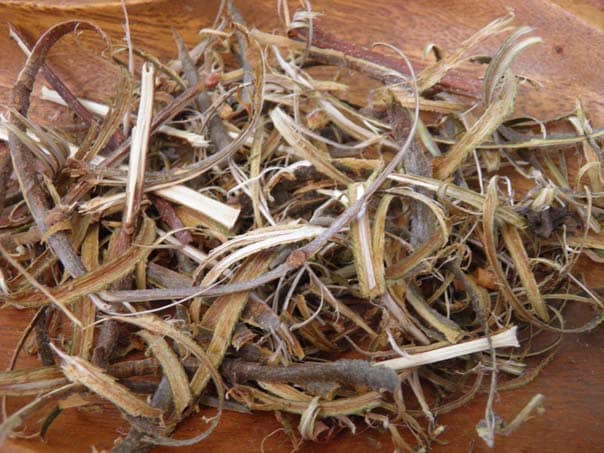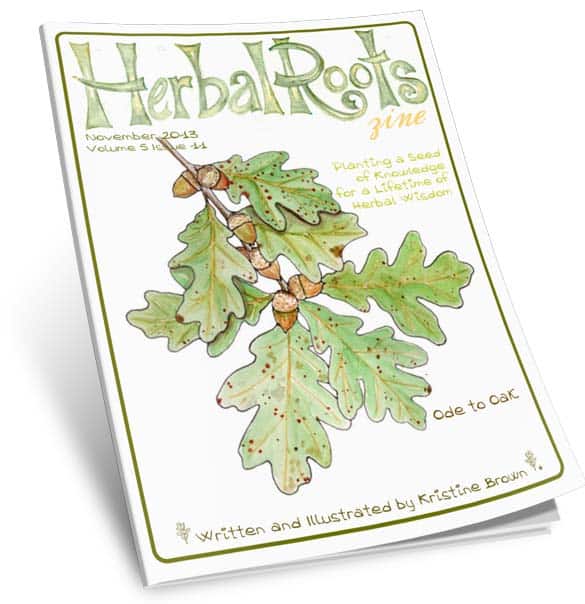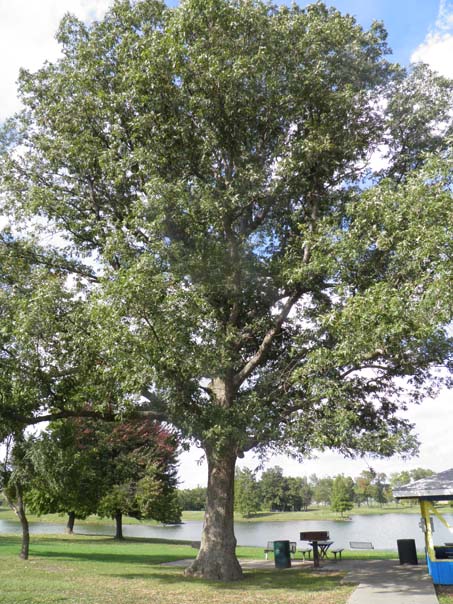The mighty oak! So much lore has been based on this magnificent tree, which can grow to be hundreds of years old, growing slowly and steadfastly. This wonderful tree offers food, shelter, medicine and so much more for both man and the creatures who live in the woods.
White Oaks are deciduous trees native to Eastern North America. They are in the Fagaceae family, which is also known as the Beech family. They are related to Chestnuts, Beech and Chinkapins. White oak’s botanical name is Quercus alba. Though this issue focuses on the medicinal uses of White Oak, other Oaks can be used medicinally. In Europe, English Oak (Q. robur) and European Turkey Oak (Q. cerris) are commonly used. In North America, many species including Swamp White Oak (Q. bicolor), Gambel Oak (Q. gambelii), Valley Oak (Q. lobata), Oregon White Oak (Q. garryanna) and Blue Oak (Q. douglasii) are often used interchangeably.

Typically, the inner bark is used for medicine. The galls and leaves can also be used. The acorns are edible though some are more palatable than others and most require boiling in several changes of water before they lose their bitter taste.
Energetically, Oak tends to be bitter, cooling and drying. You can test this out by cracking open an acorn and chewing on the raw meat. Though some acorns are sweet enough to eat directly from the shell, most will give you a taste of bitterness, leaving your mouth dry and need to be leached before using.

I have been unable to find the nutritional content for the bark but the acorns of White Oak are very nutritious. They provide lots of carbohydrates along with some protein and fat and contain many vitamins and minerals. Vitamins listed make up B-complex: thiamin (B1), riboflavin (B2), niacin (B3), pantothenic acid (B5), B6 and folate (B9). They also contain a good amount of minerals: calcium, copper, iron, manganese, magnesium, phosphorus, potassium and zinc.
Medicinally, Oak bark is considered anthelmintic, anti-inflammatory, antiseptic, antivenomous, astringent, expectorant, febrifuge, hemostatic, lithotriptic, styptic and a tonic. Oak galls and leaves are astringent. Even the acorn soak water has astringent and antiseptic actions though they are milder than the galls and bark. Let’s check out these medicinal actions one by one. For definitions of the actions, see the glossary page following this section.

As an anthelmintic, Oak is great for expelling worms from the body. Try a tea or a tincture of the bark.
Oak’s anti-inflammatory action is great for treating many issues. Appalachian herbalist Tommie Bass used Oak bark tea for treating arthritis and rheumatism.
I like to make a mouth wash from Oak bark to take advantage of his antiseptic and astringent properties, as well as his styptic activities in the case of bleeding gums. I also have used a tooth powder which contained Oak bark with the same great effects. Oak bark works wonders for treating all kinds of mouth and gum issues, including loose teeth, bad breath, canker sores, gum disease, cavities and bleeding gums. As an added bonus, the bark also whitens teeth.

Oak bark doesn’t stop at just stopping bleeding gums, he’s also great for other types of bleeding in the body, both internal and external thanks to his styptic and hemostatic actions. A poultice applied to bruises also helps to reduce the bruising. Combined with his antiseptic and astringent actions, Oak bark will do wonders for cleansing wounds and preventing infections from entering into the tissues.
For those suffering from a sore throat, a gargle helps to sooth sore throats, including strep throat and tonsillitis. Also call on Oak as an expectorant to help expel mucus in the lungs, clear up sinus congestion and post nasal drip. Combining these actions along with his febrifuge action, Oak makes a great addition to a cold care tea blend to dry up excess mucus and runny noses, sooth sore throats, ease coughs and bring down fevers.
Many have often found Oak to be effective in dissolving gallstones and kidney stones with his lithotriptic activities. I do not have any personal experience in using Oak in this manner so I cannot vouch for the effectiveness of Oak for stones. Matthew Wood mentions using Oak for ulcerations of the bladder, bloody urine and cystitis as well as when kidneys are not concentrating the urine and there are copious amounts of clear urine present.

Oak bark tea makes a great soak for feet. Tommie Bass’s favorite use was for smelly feet and Matthew Wood mentions for excessive sweating on the feet or elsewhere on the body.
As a poultice or compress, Oak does wonders for relieving varicose veins and hemorrhoids. The astringency also has been called upon to relieve diarrhea.
Acorns have long been used for food by the Native Americans and Asians. They were a very important food source and were used as a flour, a thickener, a type of pudding and added to soups and other meals for their nourishment. There are several ways to process them (we’ll discuss it more in depth in the recipe section) but the cold process is the best as it retains the most nutrition.
Oaks are slow growing trees but over time they reach massive heights and this must be considered when planting one. But, if given a chance, do plant an Oak as they are beautiful and an asset to any backyard!
One of my favorite drinks is Acorn Chai. Not only is it medicinal, but it is delicious as well! You will need to dry and roast your own acorns for making this delicious chai (instructions for doing so can be found in this month’s issue of Herbal Roots zine).

Acorn Chai
You will need:
1 tablespoon whole, roasted acorns
4 cardamom pods*
1/2 cinnamon stick*
4 peppercorns*
2 cups water
Honey and milk to taste
Begin by crushing the acorns, cardamom pods and cinnamon stick in the mortar and pestle.
Add them into the saucepan with the peppercorns and water and bring to a boil. Turn the heat down, cover the saucepan and simmer for 20 minutes.
Serve in tea cups and add milk and honey to taste. I find it to be delicious without any!
*You can find the spices listed above and White Oak bark at Mountain Rose Herbs. I prefer Mountain Rose Herbs whenever I cannot grow or wildcraft herbs myself for their amazing quality and their sustainable harvesting practices.

Want to learn more about the medicinal uses of White Oak? Find it in our shop.

